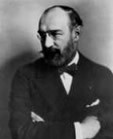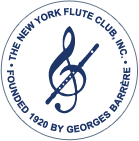
Georges Barrère
NYFC president 1920-1944
Georges Barrère (1876-1944), founder of the New York Flute Club, studied at the Paris Conservatoire with Henry Altès and Paul Taffanel, graduating with the premier prix in 1895. While still a student, Barrère played first flute with the Folies-Bergère and at the Concerts de l'Opéra. He was also first flutist in the Société Nationale and played in the premiere of Debussy's Prélude à l'Aprés-midi d'un faune in December 1894. In 1895 Taffanel assisted Barrère in establishing the Sociètè Moderne des Instruments à Vent, a woodwind chamber music society that was responsible for some 61 new compositions by 40 European composers in its first 10 years. Barrère was appointed third flute of the Concerts Colonne in 1897 and promoted to first chair in 1902. From 1900 he also played fourth flute at the Paris Opéra and taught at the Schola Cantorum.
In 1905 Walter Damrosch, eager to acquire French woodwind players, invited Barrère to become principal flutist of his New York Symphony. He held this position--except for one year's absence and intermittent short leaves--until 1928. With his silver flute, Barrère quickly revolutionized American flute playing, replacing wood flutes and the heavy German style with the lighter, more flexible, and brilliant French style. By World War I, the French model silver flute had become the standard in the United States. Barrère was a frequent soloist with the New York Symphony, premiering several works, notably the Griffes Poem (1919). From 1920 to 1928 the New York Symphony was the resident orchestra at the Chautauqua Institution in upstate New York. After 1928 Barrère was first flute, frequent soloist, and assistant conductor of the Chautauqua Symphony.
In addition to his orchestra work Barrère soon began playing recitals and chamber concerts.In 1906 he formed the New York Symphony Wind Instruments Club, which evolved into the Barrère Ensemble. He introduced New York audiences to many French works, but he also worked to cultivate a new American repertoire. In 1914 Barrère, cellist Paul Kéfer, and harpist Carlos Salzedo gave their first concert as the Trio de Lutéce, and the organization that would become the Barrère Little Symphony made its debut in Carnegie Hall. This thirteen-man organization quickly became permanent, giving some New York concerts and touring the country, often with Adolph Bolm's Ballet Intime and the Pavley-Oukrainsky Ballet, both Diaghilev offshoots.
In the 1930s Barrère founded three regular ensembles: Barrère-Salzedo-Britt, with harpist Carlos Salzedo and cellist Horace Britt; the Barrère-Britt Concertino, a quintet of flute, violin, viola, cello, and piano; and the Barrère Trio, with Britt and pianist Jerome Rappaport. Particularly with Barrère-Salzedo-Britt new music was a priority: it premiered Wallingford Riegger's Divertissement in 1933 and Bernard Wagenaar's Triple Concerto with Eugene Ormandy and the Philadelphia Orchestra in 1938.
Barrère bought his first Wm. S. Haynes flute in 1913 and became a prominent spokesman for that firm. In 1927 he made news with his acquisition of a gold Haynes and again in 1935 with the purchase of a platinum flute--the first in the United States. It was for this flute that Edgard Varèse wrote Density 21.5, which he premiered in 1936 at Carnegie Hall. During the 1930s, Barrère premiered several other pieces: Albert Roussel's Trio for flute, viola, and cello (1929), Wallingford Riegger's Suite for solo flute (1930), and Paul Hindemith's flute sonata (1936). In 1934 he was named a chevalier of the Legion of Honor.
Barrère was the key figure in establishing the Paris Conservatoire woodwind tradition in the United States. As part of his New York Symphony contract he taught at the Institute of Musical Art. In 1931 he joined the faculty of the Juilliard Graduate School, where he founded the woodwind ensemble program. Barrère also taught privately. Among his most notable students were Arthur Lora, William Kincaid, Meredith Willson, Carmine Coppola, Frances Blaisdell, Samuel Baron, and Bernard Goldberg. Barrère edited the etudes of Altés and Berbiguier and published a set of exercises, The Flutist's Formulae.
Hear Georges Barrère in 1941 playing a transcription of the gamelan piece Lagu Ardja by Colin McPhee.

 Back to Past Presidents
Back to Past Presidents